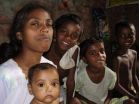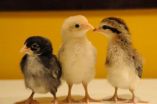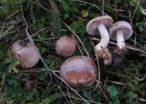(Press-News.org) Vienna, Austria: The prevalence of smoking in Christchurch, New Zealand, increased following the 2010 earthquake, according to a new study.
The results of the study will be presented today (4 September 2012) at the European Respiratory Society's Annual Congress in Vienna.
The 7.1-magnitude Christchurch earthquake, and subsequent aftershocks, have caused a huge amount of damage and dramatically changed the social, working and living conditions for residents in the city.
To investigate the effects of the disaster on smoking levels, researchers from the Canterbury District Health Board, New Zealand, carried out interviews with 1,001 residents 15 months after the first earthquake. Participants were asked about their smoking habits before and after the earthquake.
The results showed that prior to the earthquake in August 2010, 319 people were not smoking at this time. Of this group, 76 people had smoked at least once after the earthquake, with 29 people from this group having more than 100 cigarettes since September 2010.
Of the 273 people who were smoking in August 2010, 93 had increased their consumption of tobacco. 53 people in this group attributed this increase to the earthquake and the subsequent changes in lifestyle.
Professor Lutz Beckert, from the Canterbury District Health Board, said: "Increased levels of smoking were found in Christchurch residents after the earthquake. 28% of people who were not smoking prior to the earthquake picked up the habit following the quakes. This suggests that exposure to trauma, such as a natural disaster, can prompt people to start smoking as they believe it is a valid way to deal with their anxiety over their experiences and coping for changes in lifestyle.
"It is important for healthcare professionals to be aware of this increased risk in the aftermath of a disaster, such as the Christchurch earthquake, so that they can be ready to provide the necessary support to residents before they turn to cigarettes."
###
Notes to editors:
Abstract: Earthquake rattled Christchurch residents reach for cigarettes
Session: 470
Date and time: Wednesday 5 September, 08:30-10:30
Room: C1
Press Office at ERS Congress in Vienna (Saturday 1st September -Wednesday 5thSeptember 2012):
Lauren Anderson: +43 6763315356 lauren.anderson@europeanlung.org
David Sadler: +43 6767502294
Smoking and natural disasters: Christchurch residents increase tobacco consumption post-earthquake
2012-09-04
ELSE PRESS RELEASES FROM THIS DATE:
Increase in respiratory symptoms following volcanic eruption
2012-09-04
Vienna, Austria: Exposure to volcanic ash can increase respiratory symptoms such as an extreme cough, or phlegm, according to a new study.
The research, which will be presented today (4 September 2012) at the European Respiratory Society's Annual Congress in Vienna, investigated the effects of living close to the Icelandic Volcano, Eyjafjallajökull.
Eyjafjallajökull erupted in April 2010 and created a huge ash cloud which spread across Europe, causing widespread disruption to air travel on the continent.
Researchers from the University of Iceland have now examined ...
Deadly witch hunts targeted by grassroots women's groups
2012-09-04
EAST LANSING, Mich. — Witch hunts are common and sometimes deadly in the tea plantations of Jalpaiguri, India. But a surprising source – small groups of women who meet through a government loan program – has achieved some success in preventing the longstanding practice, a Michigan State University sociologist found.
Soma Chaudhuri spent seven months studying witch hunts in her native India and discovered that the economic self-help groups have made it part of their agenda to defend their fellow plantation workers against the hunts.
"It's a grassroots movement and it's ...
New genetic clues to why most bone marrow transplant patients develop graft-versus-host disease
2012-09-04
SEATTLE – A team of scientists led by a bone marrow transplant researcher at Fred Hutchinson Cancer Research Center has shed new light on why most bone marrow transplant patients who receive tissue-matched cells from unrelated donors still suffer acute graft-versus-host disease (GVHD). The answer appears to lie in the discovery of previously undetected genetic differences in the DNA of patients and unrelated marrow donors.
The laboratory-based study findings by Effie Petersdorf, M.D., and colleagues soon will be translated to the clinic when a Hutchinson Center transplant ...
Magazine articles jeopardize and empower young women’s sexuality
2012-09-04
Los Angeles, CA (September 4, 2012) While the effects of sexualized media on young women has long been debated, a new study finds that women who read sex-related magazine articles from popular women's magazines like Cosmopolitan are less likely to view premarital sex as a risky behavior. Additionally, the women who are exposed to these articles are more supportive of sexual behavior that both empowers women and prioritizes their own sexual pleasure. This study was published in a recent article from Psychology of Women Quarterly (published by SAGE).
Study authors Janna ...
Using magnetism to understand superconductivity
2012-09-04
Might it one day be possible to transmit electricity from an offshore wind turbine to land-based users without any loss of current? Materials known as "high temperature" superconductors (even though they must be maintained at -140°C!), which can conduct electricity without any losses, were supposed to make this dream a reality. But over the past twenty-five years, scientists have not been able to make any progress in this area. Research being done in EPFL's Laboratory for Quantum Magnetism (LQM) could change that. Their study of magnetism at extremely small scales could ...
Hormone therapy for fruit flies means better pest control
2012-09-04
Released en masse, sterile Mexican fruit flies can undermine a wild population of the fruit-damaging pests so that fewer applications of insecticide are needed. But the irradiation used to sterilize the flies weakens them, hindering their ability to outcompete wild-type males for female mates.
Now, U.S. Department of Agriculture (USDA) and collaborating scientists have devised a hormone therapy for making sterile flies "more macho," improving their chances of mating with female flies before their wild rivals do. Peter Teal, a chemist with USDA's Agricultural Research ...
New gene variants raise risk of neuroblastoma, influence tumor progression
2012-09-04
Researchers have discovered two gene variants that raise the risk of the pediatric cancer neuroblastoma. Using automated technology to perform genome-wide association studies on DNA from thousands of subjects, the study broadens understanding of how gene changes may make a child susceptible to this early childhood cancer, as well as causing a tumor to progress.
"We discovered common variants in the HACE1 and LIN28B genes that increase the risk of developing neuroblastoma. For LIN28B, these variants also appear to contribute to the tumor's progression once it forms," said ...
New Delft model: Coastline erosion due to sea level rise greater than previously thought
2012-09-04
Coastline recession
The anticipated rise in sea levels due to climate change will result in coastlines receding worldwide through erosion. This is a known phenomenon that can in principle be calculated and predicted based on a given sea-level rise, by means of the so-called Bruun effect. However, things are a little more complicated when it comes to coastlines in the vicinity of inlets, such as river mouths, lagoons and estuaries. These places are affected by other factors, such as changes in rainfall due to climate change, and certain compensating effects (basin infilling).
Accurate ...
For the rooster, size matters
2012-09-04
A lone rooster sees a lot of all the hens in the flock, but the hen with the largest comb gets a bigger dose of sperm - and thus more chicks. This sounds natural, but behind all this is humanity's hunger for eggs.
For thousands of years, people have tinkered with the development of domestic chickens. Through selective breeding for a few characteristics such as large muscle mass and increased egg-laying, we have at the same time caused numerous other radical changes in appearance and behaviour. A research group at Linköping University in Sweden has now shown how the size ...
New Danish fungal species discovered
2012-09-04
A new fungal species, called 'Hebelomagriseopruinatum', has now officially been included in the list of species. The fungus, whose name can be translated into 'the grey-dewy tear leaf', was discovered on Zealand in Denmark during a mushroom-hunting tour headed by postdoc Jacob Heilman-Clausen from the University of Copenhagen.
During a mushroom-hunting excursion in 2009, postdoc Jacob Heilman-Clausen from the Center for Macroecology, Evolution and Climate at the Department of Biology, University of Copenhagen, was handed a very interesting looking fungus.
Following ...


